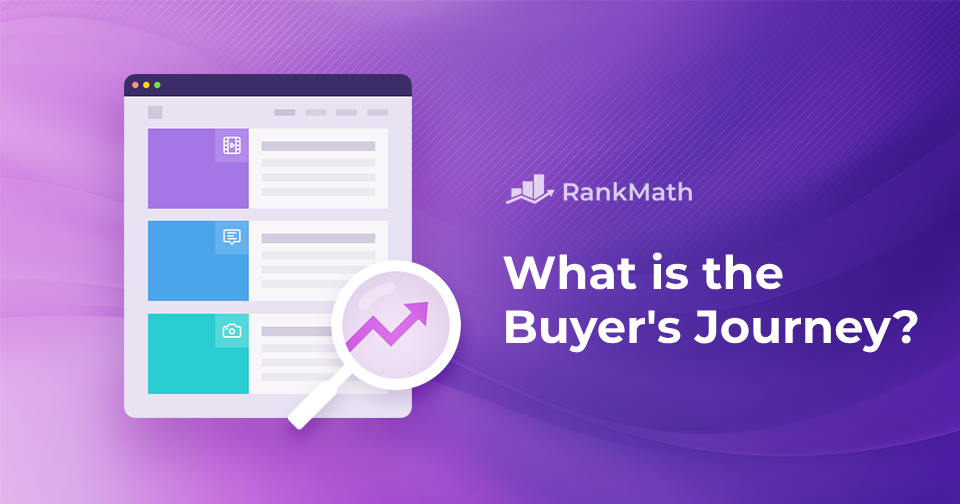Understanding your customer’s mindset and journey is important for success.
This is where the concept of the buyer’s journey comes into play.
The buyer’s journey is a framework that maps out the path prospective customers take from the moment they become aware of a problem or need to the final decision to purchase a product or service.
By understanding the buyer’s journey, you can create content and marketing strategies to effectively engage and guide potential customers at every stage of their decision-making process.
In this post, we’ll discuss everything you need to know about the buyer’s journey and help you create content at each stage of the buyer’s journey.
So, without any further ado, let’s get started.
Table Of Contents
1 What is the Buyer’s Journey?
The buyer’s journey is a framework that outlines the process potential customers go through from the moment they recognize a need or problem to the point where they make a purchase decision.
The buyer’s journey is typically divided into three key stages: Awareness, Consideration, and Decision.
Each stage represents a different phase of the customer’s experience and requires unique content to address their specific needs and concerns.
In the Awareness stage, potential customers recognize a problem or need and seek information.
During the Consideration stage, they evaluate various solutions.
Finally, in the Decision stage, they choose a specific solution and prepare to make a purchase.
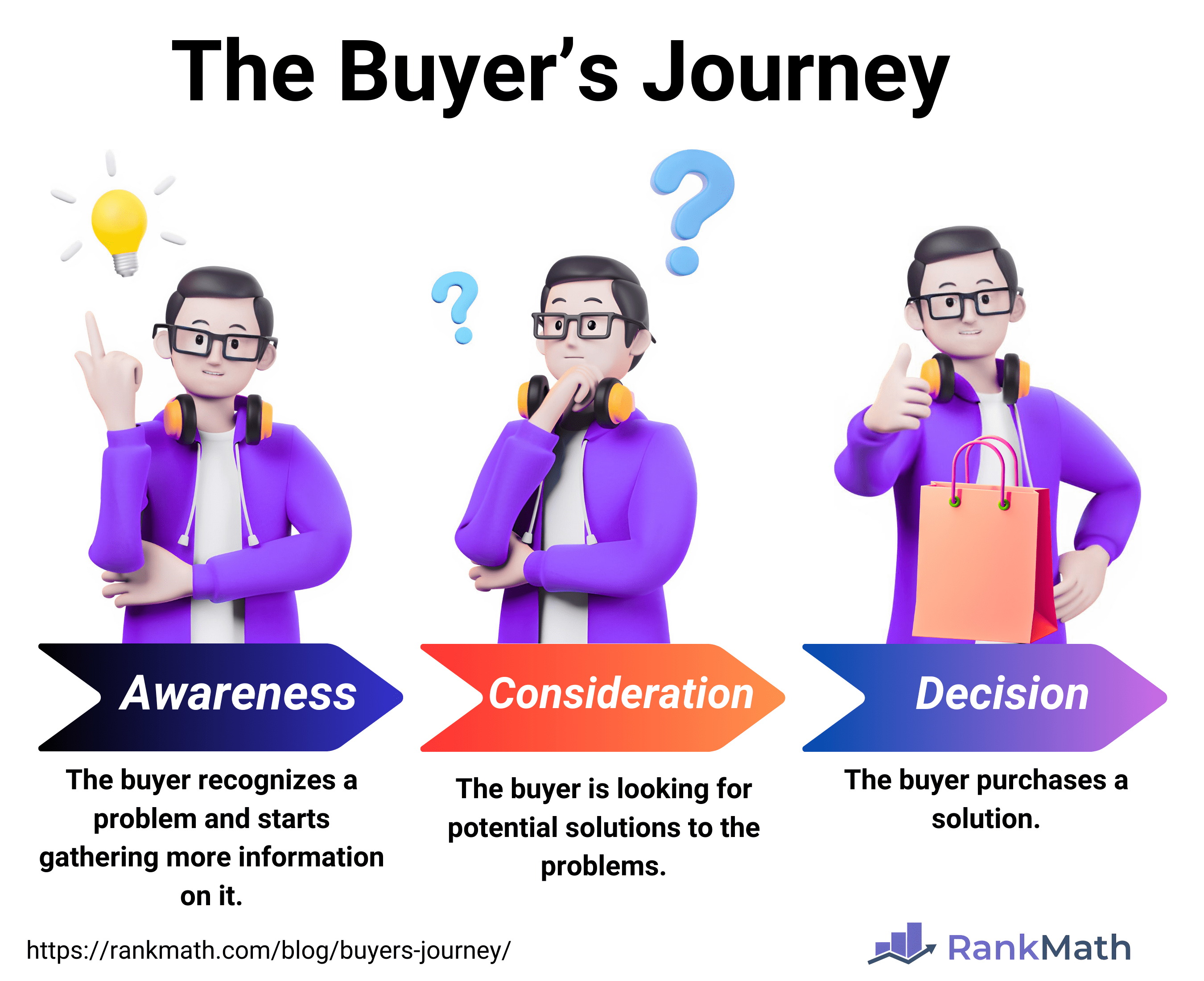
Creating the right content for each stage of the buyer’s journey is essential for capturing attention, nurturing leads, and converting prospects into loyal customers.
Let us now discuss how to create content for the buyer’s journey.
2 How to Create Content for the Buyer’s Journey
Creating content for the buyer’s journey involves customizing your marketing content to address the specific needs and concerns of potential customers at each stage of their decision-making process.
2.1 Create Buyer’s Persona
Buyer personas, which are fictional profiles representing different types of prospects, help you understand the audience segments you’re targeting.
Step 1: Get to Know Your Customers
- Identify Best Customers: Reach out to customers who quickly understand and effectively use your product.
- Conduct Interviews or Surveys: Ask them about their experiences, likes, dislikes, problems, and responsibilities related to your product.
- Collect Insights: Gather detailed information about their demographics, socioeconomic status, personality, habits, pain points, and content preferences.
To create effective buyer personas, it’s essential to conduct audience research. You can use Semrush’s One2Target tool to conduct your audience research.
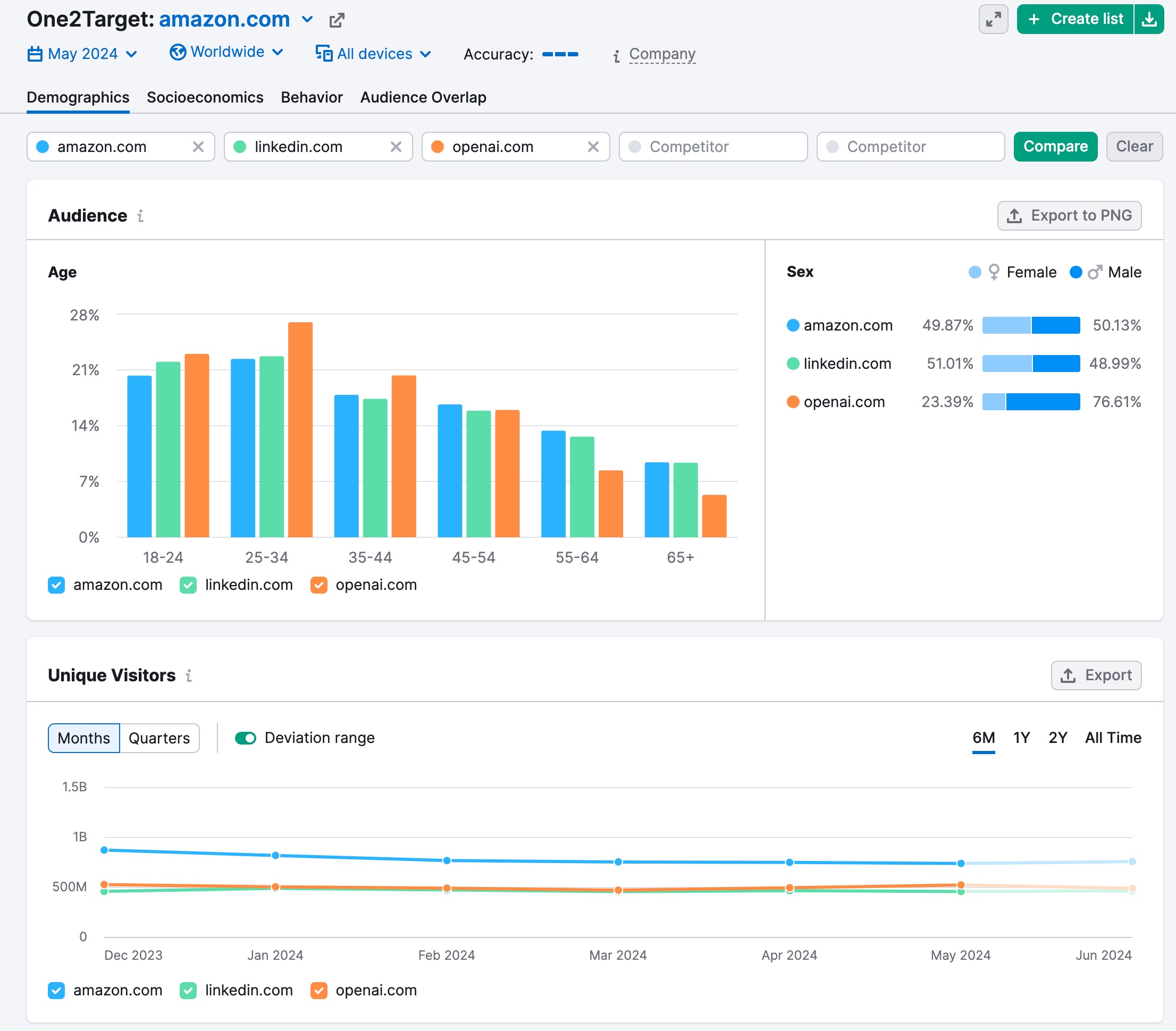
Step 2: Organize the Data
Look for commonly repeated phrases, words, and remarks among the customer responses.
Organize the data into categories based on the identified patterns, which will help understand different audience segments.
Step 3: Segment the Audience
Based on the patterns, develop fictional profiles that represent each specific audience segment. These profiles can be based on:
- Demographics
- Socioeconomic status
- Personality and habits
- Pain points
- Content preferences
You can use Google Analytics 4 to collect data about your customers based on demographics, location, and technology. To do so, navigate to Reports → User → User attributes → Overview from your Google Analytics 4 account.
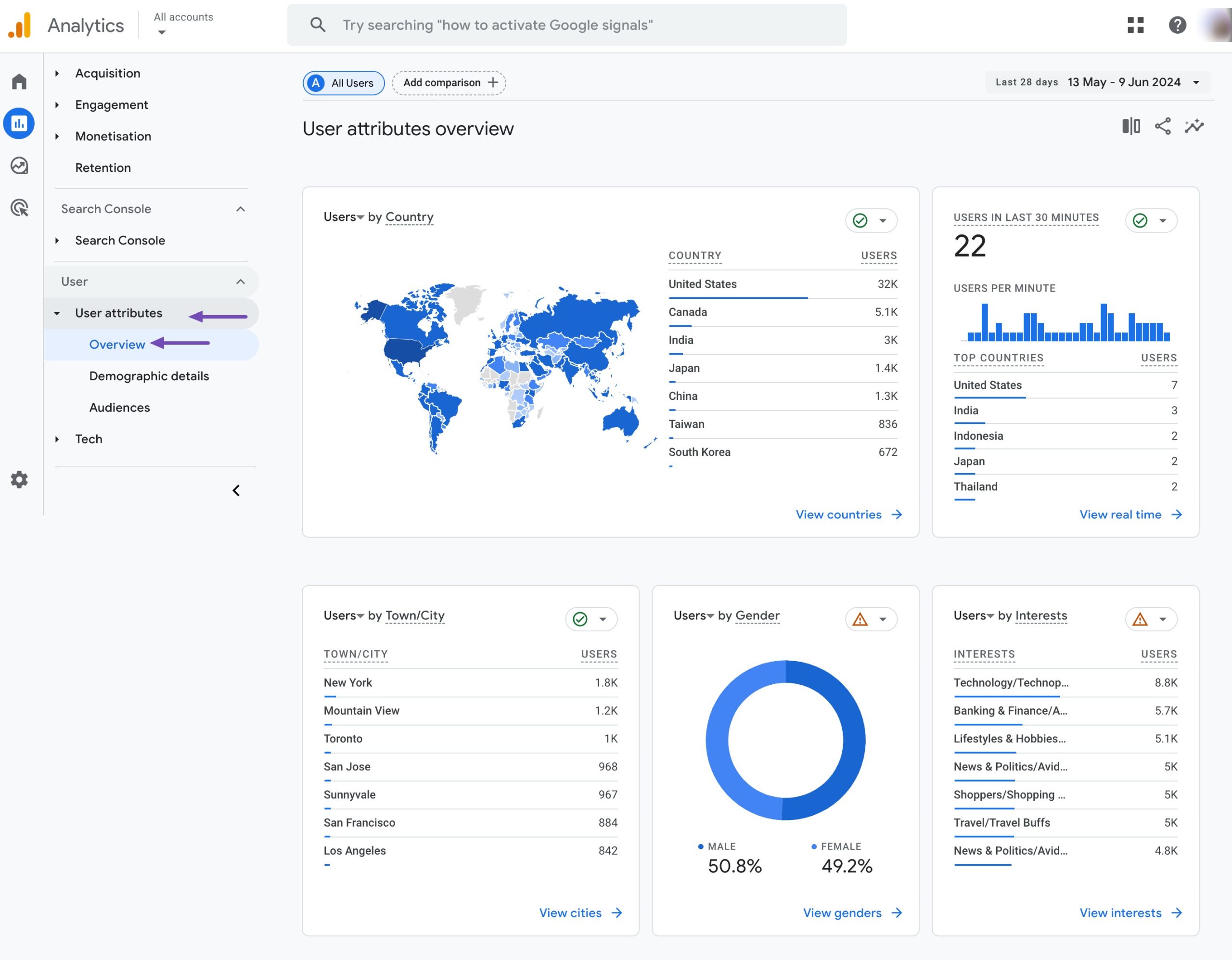
You can use the Audiences report to observe how predefined or custom segments (such as users in New York) interact differently with your site.
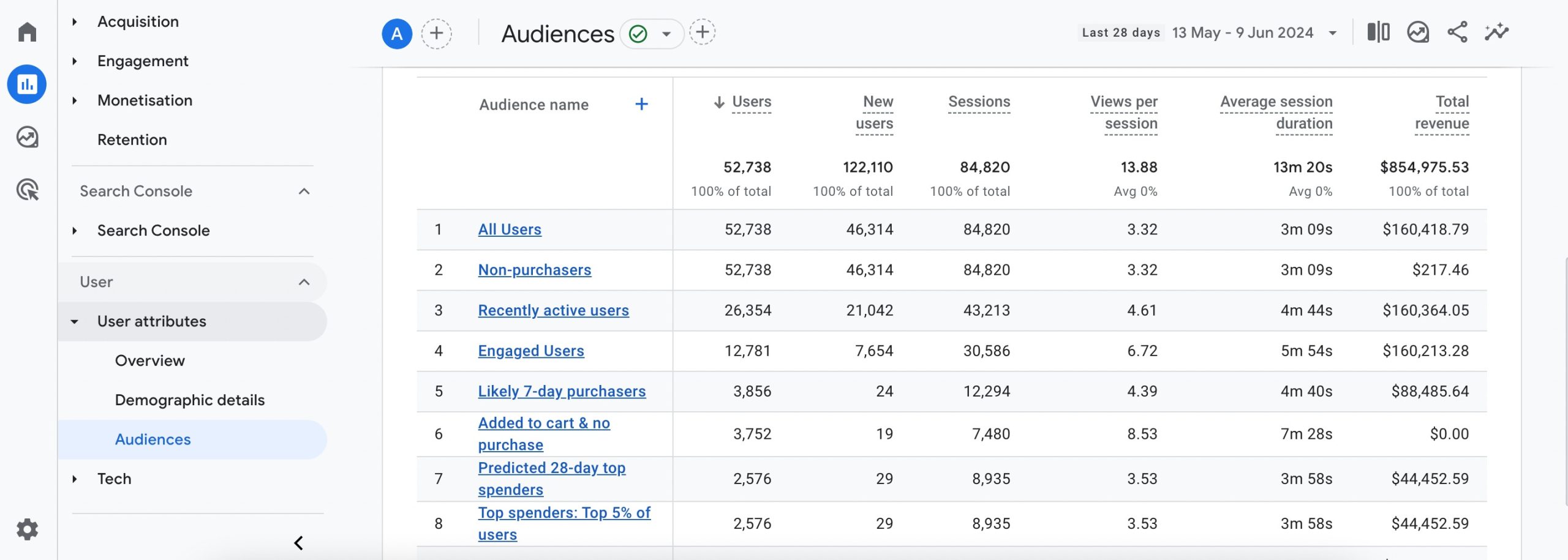
2.2 Find Topics That Match Each Stage of the Buyer’s Journey
Finding topics that match each stage of the buyer’s journey is essential for creating targeted content that guides potential customers from awareness to decision-making.
Each stage in the buyer’s journey requires specific types of content to address the needs and questions of your audience.
In the Awareness stage, as the potential customers are just beginning to recognize a problem or need, the goal is to attract attention and educate your audience about the issues they might be facing.
Topics for this stage should focus on identifying and understanding problems. Informational search intent addresses the awareness stage.
For instance, if you are a company selling home security systems, topics can include The Top 10 Signs Your Home Might Be Vulnerable to Burglars or How to Secure Your Home Against Common Break-In Methods. These topics help raise awareness and provide the necessary information about home security issues.
You can use Rank Math’s Topic Research tool to find relevant topics.

In the Consideration stage, as the potential customers are evaluating different solutions to their problem, content in this stage should provide in-depth information about different solutions.
Commercial keywords address the consideration stage. Continuing with the home security example, relevant topics might include Comparing DIY vs. Professional Home Security Systems or The Benefits of Smart Home Security Technology.
This type of content helps prospects understand the various options available and consider the best fit for their needs.
Finally, in the Decision stage, as the potential customers are ready to make a purchase decision, they need content that helps them finalize their choice and reassures them that they’re making the right decision.
Topics for this stage should focus on your product’s unique benefits and customer success stories. For instance, Customer Testimonials: How Our Security System Prevented a Break-In or A Comprehensive Guide to Setting Up Our Home Security System.
2.3 Create Content for Each Stage
Now that you’ve identified the topics for each stage of the buyer’s journey, it’s time to start creating content for them.
Create Content for the Awareness Stage
At this stage, your audience is just starting to recognize that they have a need or an issue, so your goal is to provide informative and engaging content that attracts their attention and builds trust.
The types of content that work well in the Awareness stage include blog posts, social media posts, infographics, and educational videos.
The focus of all these content types should be on addressing the pain points and problems that your potential customers face. By identifying and discussing these issues, you show empathy and understanding, which helps in building trust.
To attract attention and build trust, you can include using compelling headlines and visuals to draw in your audience, optimizing your content for search engines to increase visibility, and sharing your content across multiple platforms to reach a wider audience.

Consistency is key—regularly publishing high-quality content helps establish your brand as a reliable source of information. Additionally, engaging with your audience through comments and social media interactions can develop a sense of community and trust.
Create Content for the Consideration Stage
At this stage, your audience is aware of their needs and actively seeks information to compare options. Your goal is to provide detailed, valuable content that highlights your expertise and positions your products or services as viable solutions.
The types of content that work well in the Consideration stage include ebooks, webinars, whitepapers, and comparison guides.
Your content in the Consideration stage should focus on presenting solutions and addressing common objections. Clearly mention the benefits of your product or service and explain how it solves the problems identified in the Awareness stage.
Address any potential concerns or objections head-on, providing evidence, testimonials, or case studies to back up your claims.
Offer content rich in useful information and insights to provide value and nurture leads. Ensure your ebooks, webinars, whitepapers, and guides are easily accessible, perhaps in exchange for contact details, which can help you build your email list for further nurturing.
For instance, Moz provides webinars that dive deep into SEO strategies. They also have whitepapers and comparison guides that contrast their SEO tools with those of competitors.
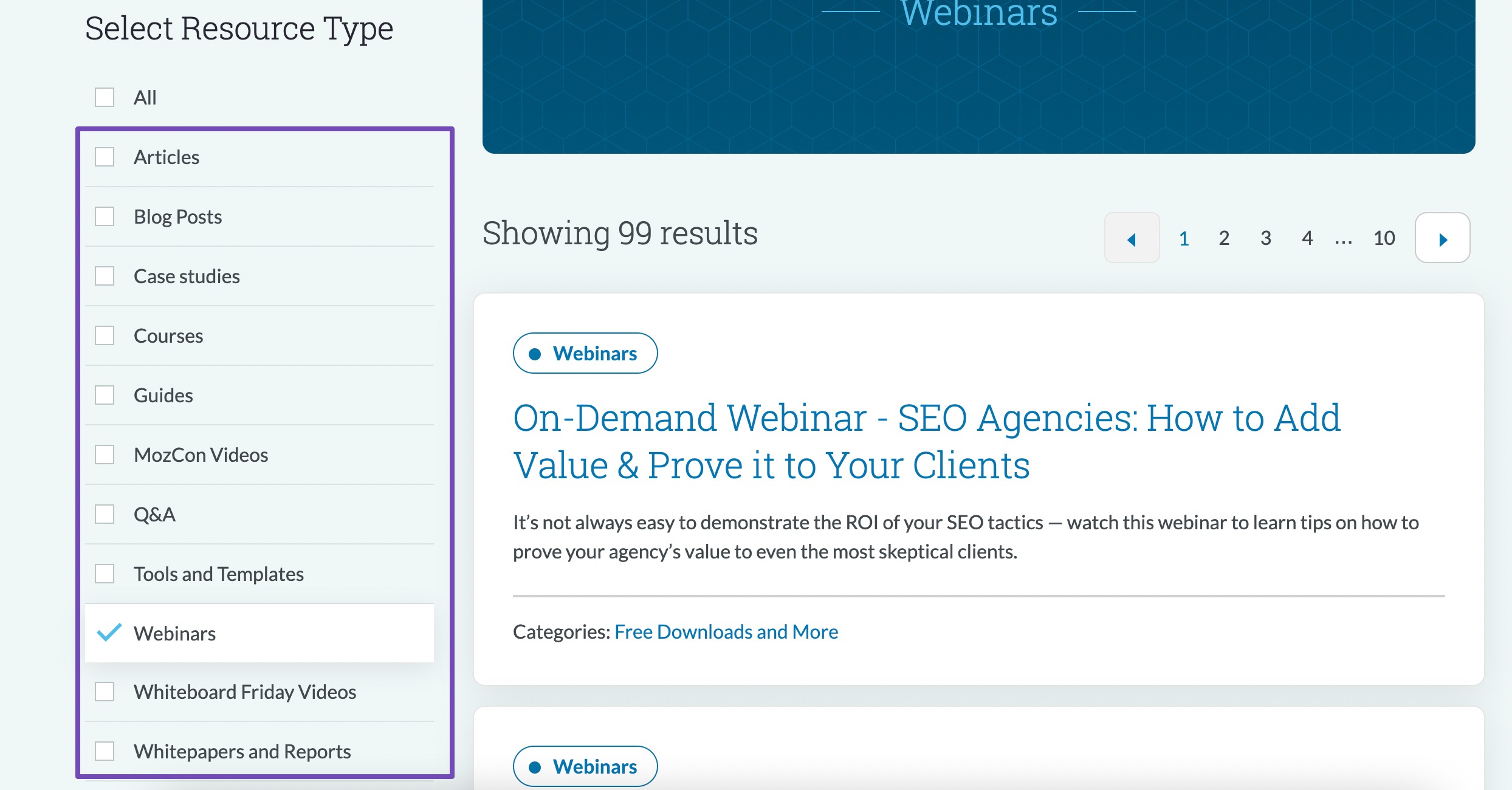
Follow up with personalized emails that offer additional resources, answer questions, and guide the customers toward the Decision stage.
Engage with your audience through comments, social media interactions, and follow-up communications to keep the conversation going and demonstrate your ongoing commitment to helping them find the best solution.
Create Content for the Decision Stage
At this stage of the buyer’s journey, your audience is ready to choose a solution, so your content should focus on proof and validation to reassure them that they are making the right decision.
The types of content that are particularly effective in the Decision stage include case studies, testimonials, product demos, and free trials.
The focus of the Decision-stage content should be proof and validation. You need to address any lingering doubts or objections and provide solid evidence that your product or service delivers on its promises. Use data, real-world results, and personal stories to build a compelling case.
For instance, a series of customer testimonials combined with a detailed case study can create a powerful narrative that underscores your product’s reliability and effectiveness.
Salesforce’s website features a dedicated section called Customer Stories, which showcases detailed case studies and customer testimonials.
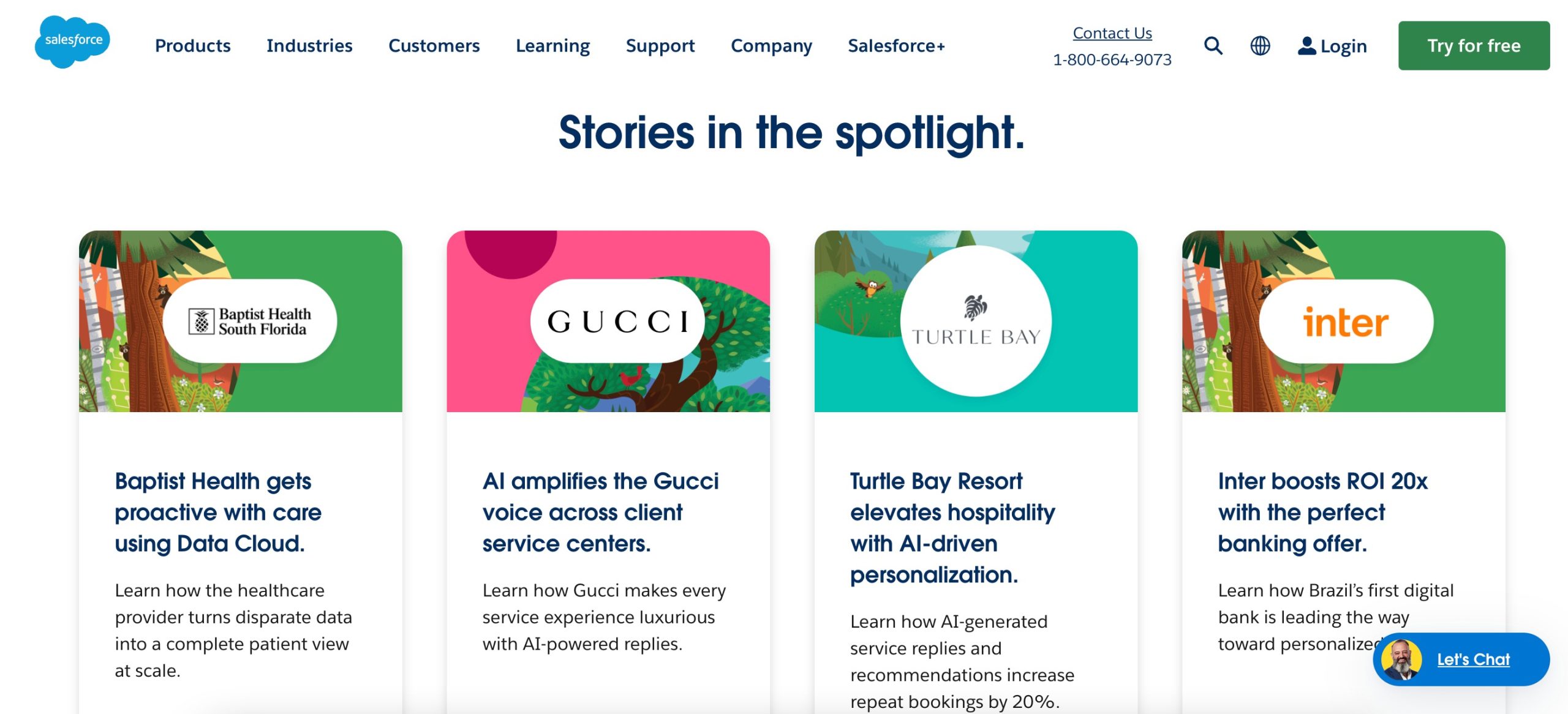
Strategies for encouraging purchase and closing the sale include creating a sense of urgency and offering incentives.
2.4 Add Appropriate Calls to Action for Each Piece of Content
Adding appropriate calls to action (CTAs) for each piece of content is important to guide your audience toward the next step in their buyer’s journey.
A well-created CTA not only tells the reader what to do next but also provides a clear path to deeper engagement with your brand.
The effectiveness of a CTA depends on its relevance to the content and its alignment with the user’s current stage in the buyer’s journey.
For content in the Awareness stage, such as blog posts or social media updates, the CTAs should encourage further exploration and engagement.
Effective CTAs inlcude Learn More, Read Our Latest Guide, or Follow Us on Social Media.
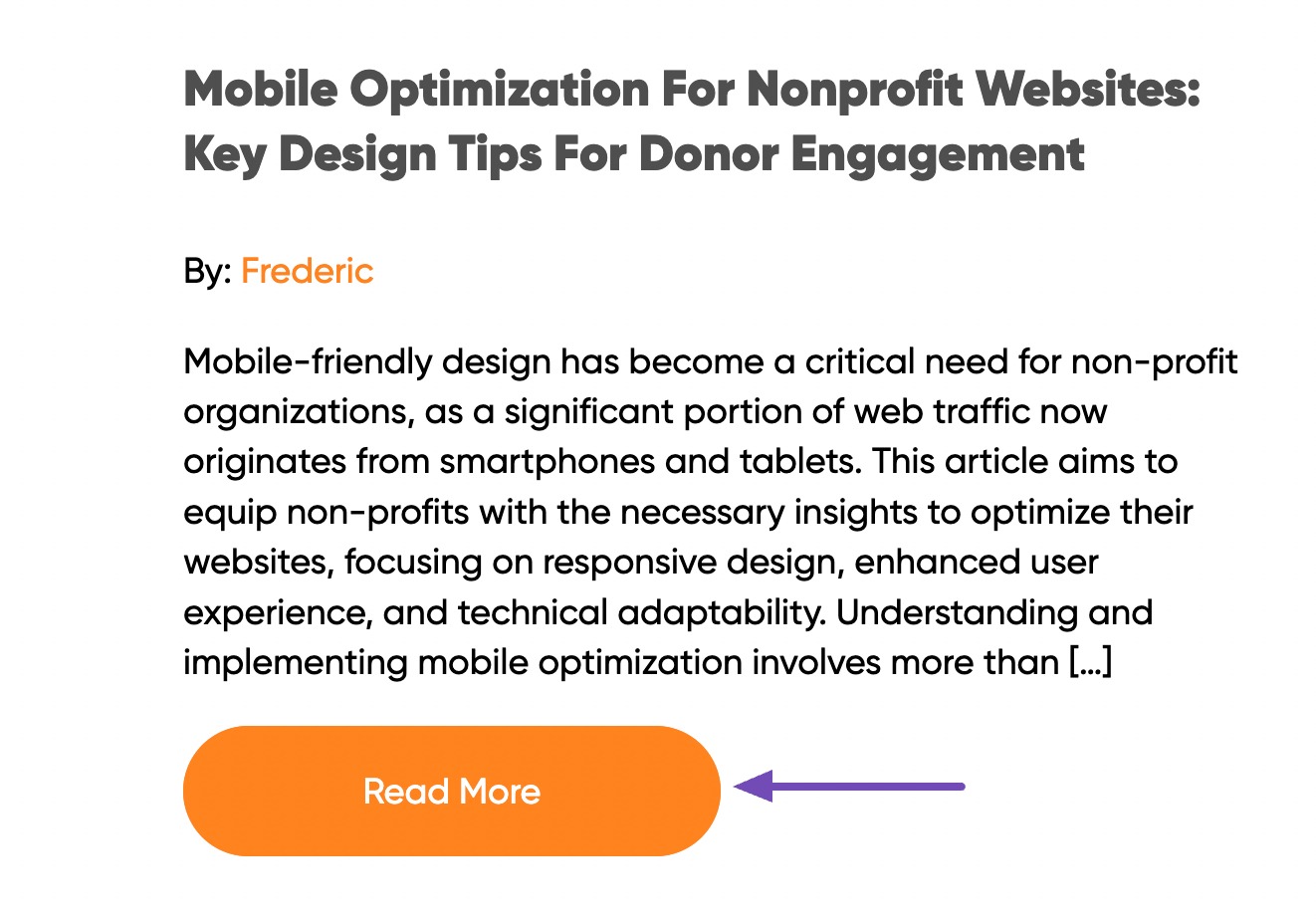
For instance, a blog post on the basics of home security can end with a CTA like, Download our free eBook on advanced home security tips, inviting the reader to dig deeper into the topic.
In the Consideration stage, where customers evaluate different solutions, CTAs should focus on offering more detailed and valuable content that helps in their decision-making process.
Effective CTAs at this stage include Download Our Comparison Guide, Watch Our Webinar, or Request a Demo.
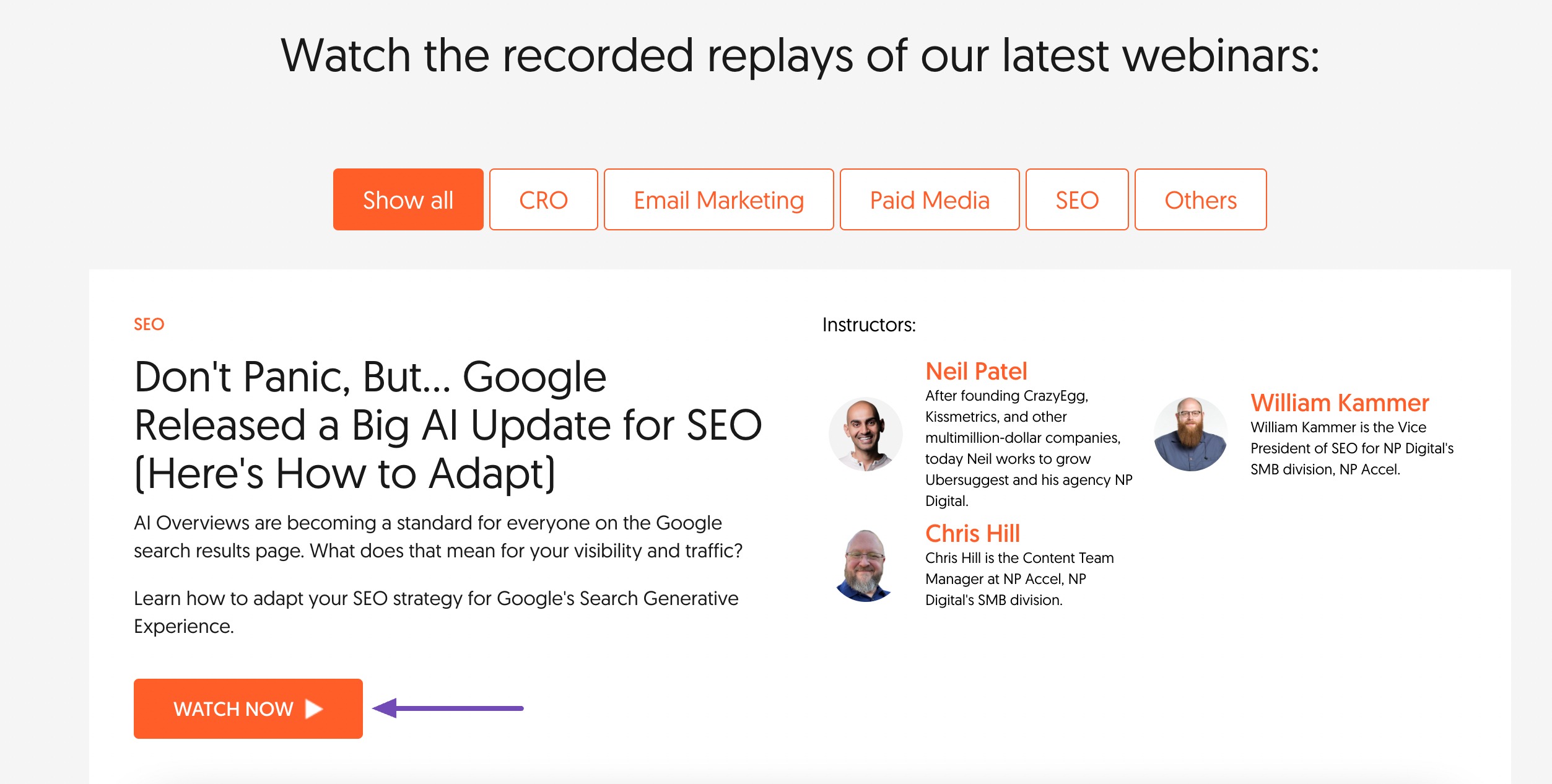
For instance, an ebook on various home security systems can conclude with a CTA like, Sign up for a free webinar on choosing the right home security system for your needs, guiding the reader to a more interactive and informative piece of content.
For the Decision stage, CTAs should aim to convert the audience into customers by emphasizing trial opportunities, consultations, or direct purchases.
Examples include Start Your Free Trial, Schedule a Consultation, or Buy Now. A product demo video, for instance, might end with a CTA such as, Get a free trial of our home security system today, offering a hands-on opportunity to experience the product’s benefits.
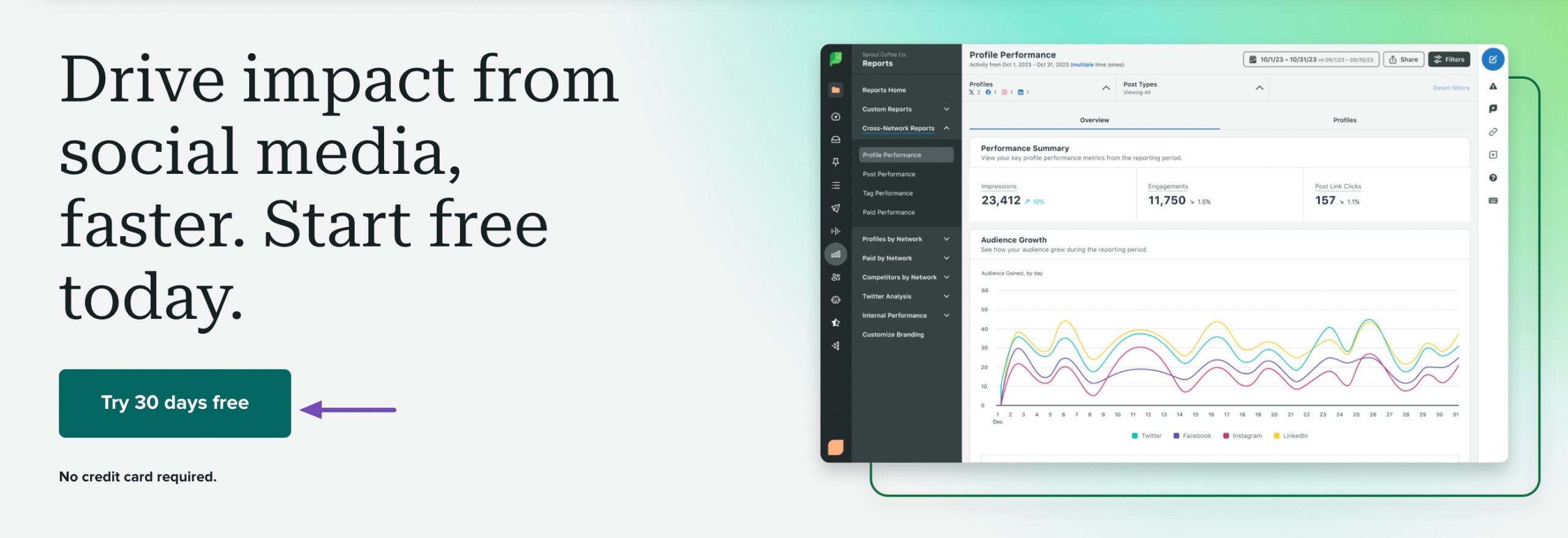
To maximize effectiveness, ensure your CTAs are clear, concise, and compelling. They should stand out visually, using buttons or highlighted text, and include action-oriented language that conveys a sense of urgency or benefit.
3 Conclusion
Understanding and effectively addressing each stage of the buyer’s journey is essential for any successful marketing strategy.
By developing your content according to the specific needs and behaviors of your audience at the Awareness, Consideration, and Decision stages, you can smoothly guide potential customers from initial interest to final purchase.
Creating relevant and engaging content helps build trust and credibility, nurture leads, and drive conversions.
Focusing on the buyer’s journey and delivering valuable content at every stage can enhance customer satisfaction, develop long-term loyalty, and ultimately achieve business goals.
If you like this post, let us know by Tweeting @rankmathseo.
